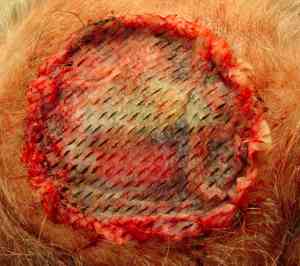

MedFriendly®


Xenograft
A xenograft is a tissue from an animal that is
transplanted (transferred) to another species of animal.
An example is when skin is taken from a pig and used to
temporarily cover up damaged skin of another animal
species because of a severe burn injury.
This is usually done when there is not good enough
tissue from elsewhere in the burn victim's body to be
used to cover up the burn wound or when tissue from a
tissue bank is not available. The transplanted tissue will
quickly be rejected by the burn victim, but it will provide
a cover for a few days, which will decrease fluid loss
from the open wound.
A xenograft on the head from
the skin of the pig.
FEATURED BOOK: The Art and Science of Burn Wound Management
The difference between a xenograft and a zoograft is that a zoograft is a tissue that is
always transferred from an animal to a human. So whereas a zoograft always means a
transplant from an animal to a human, a xenograft does not always mean this, although it
can mean this. For example, a xenograft can be a tissue transplant from a pig to a gorilla,
but it can also be a tissue transplant from a pig to a human. Zoografts will always be
transplants from animals to humans. Xenografting is the process of transplanting
(transferring) a tissue from one species of animal to another. Xenograft is also known as
heterograft, heterotransplant, heterologous graft, heteroplastic graft, and xenogeneic
graft. Xenograft comes from the Greek word "xenos" meaning "strange," and the Greek
word "grapheion" meaning "a writing instrument." Put the words together and you have
"strange writing instrument." The reason for this is because in a pencil-shaped instrument
is used during grafting.
"Where Medical Information is Easy to Understand"™















